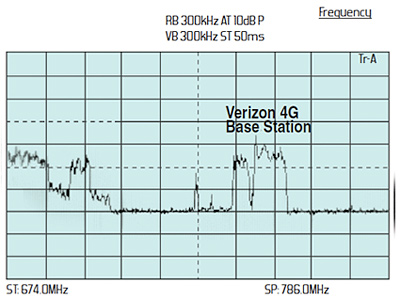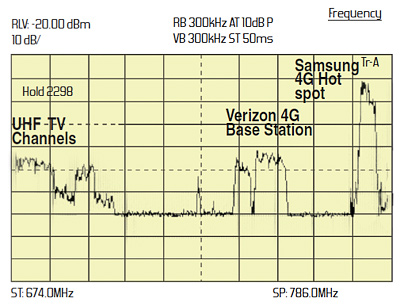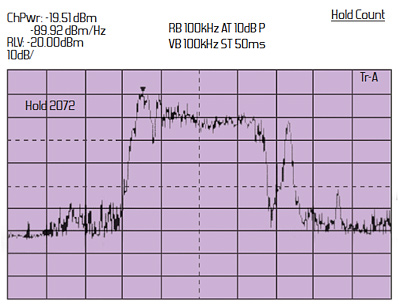4G Interference to UHF DTV

Last month I mentioned that I was seeing interference from my Verizon Samsung SCH-LC11 LTE 4G hot-spot in some USB ATSC receivers. During the past month I had a chance to look into this in more detail and capture some spectrum analyzer photos showing emissions from the hot-spot. I think I've identified the interference mechanism.
This month I'll look at the 700 MHz 4G spectrum allocations, how they are used by wireless carriers, and the potential impact of this use on DTV stations operating on higher UHF channels.
700 MHZ 4G BACKGROUND
Checking the FCC's Auction 73 Web page, I confirmed Verizon's core upper 700 MHz was in the C-block, which consists of 22 MHz of paired spectrum (746–757 MHz and 776–787 MHz). Verizon also picked up adjacent A-block spectrum in some markets (757–758 MHz and 787–788 MHz). This spectrum used to be TV channels 60–61 and 65–66.
AT&T holds spectrum in the lower 700 C-block (710–716 MHz and 740–746 MHz) primarily purchased from earlier auction winners. In Auction 73, AT&T picked up spectrum in some markets in the B-block (704–710 MHz and 734–740 MHz). The combined AT&T spectrum used to be UHF channels 53–54 and 58–59.

Fig. 1: Spectrum without hot spot From what I was able to determine with my spectrum analyzer, Verizon is using its spectrum centered around 781.5 MHz for transmission from the 4G devices to the cell tower and spectrum centered around 751.5 MHz for transmission from the cell site to devices.
Fig. 1 shows a spectrum display from 674 MHz, the lower edge of TV channel 48, to 786 MHz, the upper limit of Verizon's 700 MHz spectrum) with the 4G hot-spot turned off and Fig. 2 shows what happened when I turned on the hot-spot and connected to the Internet.
I used a Terk HDTV-1a amplified log-periodic antenna with preamplifier enabled for these measurements. A 5.4 dB minimum loss pad was used to match the 75 ohm amplifier to the 50 ohm analyzer input. Because the signals from the hot-spot were intermittent I used the max-hold feature on the analyzer to catch them.
I let the analyzer run for more than 2,000 samples. These are a sufficient number of samples to stabilize the measured peak power within a few tenths of a dB. The hot-spot was located three feet from the center of the TV antenna at a 45-degree angle off of the back of the antenna.
As you can see in Figure 2, in some spots the peak hot-spot signal was 40 dB or more stronger than measured TV signals on channel 48 and above. For determining interference, it is appropriate to use the average signal level of the DTV signal than the peak level, so the actual interference ratio would be several dB higher.
RECEIVER DEFICENCIES

Fig. 2: Spectrum with hot spot A glance at the FCC's Office of Engineering and Technology 2007 report on DTV Interference Rejection Thresholds shows single conversion receivers are sensitive to interference from signals 14 and 15 channels above the desired channel due to image response in the receiver. The interference from signals seven channels away was originally thought to be caused by the undesired signal beating with the desired signal and creating interference that can pass through the receiver's IF filter.
However, the OET study suggested that another mechanism may be at work—interference occurs only when the undesired signal overlaps the local oscillator frequency of the receiver, indicating the undesired signal may be interacting with the local oscillator.
The 2007 FCC study found the N+7, N+14 or N+15 signal had to be much stronger than the received signal—more than 40 dB stronger—to cause interference to the tested receivers. Performance varied from receiver to receiver.
While KOCE, the PBS station in Los Angeles, is not exactly 7, 14 or 15 channels below the Verizon signals, I suspect the hot-spot's high signal level and wide bandwidth of the 4G signal could be causing problems for the tuner in my USB ATSC tuner, which depends on filtering in the silicon tuner to reject undesired signals.
Fig. 3 shows an expanded view of the 11 MHz Verizon C-Block spectrum used by the hot-spot. Before getting too excited about the channel power level, note that this level includes the peak power of 2,072 samples, not the instantaneous power.

Fig. 3: 4G uplink spectrum If my analysis is correct, some viewers of DTV stations operating on channels 50 and 51 may experience problems with indoor reception if a Verizon 4G device is nearby and their receiver's filtering isn't up to par. Depending on what band AT&T picks for its 700 MHz consumer devices, viewers of TV stations on channels 38–40 or 43–45 may have problems with reception when AT&T 700 MHz devices are being used nearby.
During a recent visit to San José I experienced interference to KQEH, RF channel 50, while using an indoor antenna in a hotel room with my hot-spot off, which looked similar to the interference I saw from my own hot-spot. But without a spectrum analyzer I couldn't confirm that.
More study is needed, but I don't think the Verizon Samsung hot-spot itself is to blame. The real cause of the interference is likely a lack of filtering in some ATSC USB tuners and the proximity of the 700 MHz device to the TV antenna. The fact that some newer receivers, like the Hauppauge Aero-M, perform much better supports this.
Set-top boxes might be less susceptible to this interference since they had to pass NTIA certification. Any tuner using a double conversion front end should be immune to the N+14 or N+15 interference. Manufacturers of ATSC MH receivers for tablets and smartphones will need to consider potential interference from 4G 700 MHz transmitters in these devices if the 700 MHz transmitter is not shut off while watching TV.
Do you have a 4G phone or 4G wireless hot-spot? If so, see whether it creates any interference to your indoor DTV reception on upper UHF channels and let me know the results. If I get enough responses, I'll cover them in a future RF Technology column.
Comments are welcome! E-mail me at dlung@transmitter.com.
Get the TV Tech Newsletter
The professional video industry's #1 source for news, trends and product and tech information. Sign up below.

Doug Lung is one of America's foremost authorities on broadcast RF technology. As vice president of Broadcast Technology for NBCUniversal Local, H. Douglas Lung leads NBC and Telemundo-owned stations’ RF and transmission affairs, including microwave, radars, satellite uplinks, and FCC technical filings. Beginning his career in 1976 at KSCI in Los Angeles, Lung has nearly 50 years of experience in broadcast television engineering. Beginning in 1985, he led the engineering department for what was to become the Telemundo network and station group, assisting in the design, construction and installation of the company’s broadcast and cable facilities. Other projects include work on the launch of Hawaii’s first UHF TV station, the rollout and testing of the ATSC mobile-handheld standard, and software development related to the incentive auction TV spectrum repack. A longtime columnist for TV Technology, Doug is also a regular contributor to IEEE Broadcast Technology. He is the recipient of the 2023 NAB Television Engineering Award. He also received a Tech Leadership Award from TV Tech publisher Future plc in 2021 and is a member of the IEEE Broadcast Technology Society and the Society of Broadcast Engineers.
